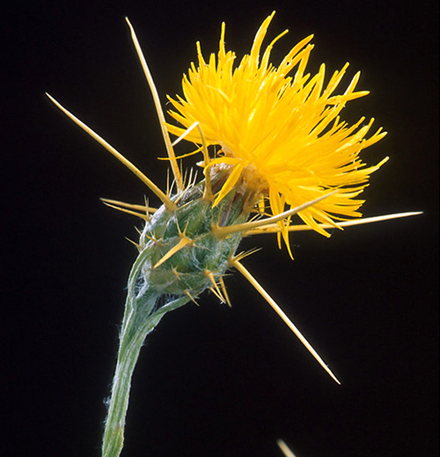Grecian Import May Help Clear Out Invasive Plant

Yellow star thistle. (Photo by Peggy Greb)
More than 80% of American states have been claimed as “home” by yellow star thistle (YST), an invasive plant from the Mediterranean. While national data are unavailable, YST costs California alone an estimated $25 million per year in control efforts, less forage for livestock, and reduced recreational spaces.
Land managers have made many attempts over the years to control yellow star thistle – including the application of herbicides, mowing, controlled burning, and managed grazing – but they have achieved only limited success. Scientists from the Agricultural Research Service (ARS) are now adding a new tool to the integrated pest management (IPM) mix: a natural predator of YST known as the rosette weevil. IPM combines multiple science-based tactics to reduce the risk of pests developing resistance to any one method.
According to Brian Rector, entomologist with the ARS Invasive Species and Pollinator Health Research Unit (ISPH) in Albany, CA, using natural predators (“biological control agents”) is an environmentally sound way to control YST.
“We develop biologically-based management strategies of invasive species through classical biological control — we reunite targeted species (in this case the yellow star thistle) with natural enemies collected from their native ranges,” he explained. Experimental studies suggest that the rosette weevil, collected from Greece, would greatly reduce the densities of mature plants in many areas of the Western United States and would not affect native plant species.
Yellow star thistle has infested more than 20 million acres in 8 Western states (41 states, overall). Just one of the spiky plants can produce as many as 100,000 seeds per year, and seeds can survive in the soil for up to 10 years.
The 5-year project examines how the rosette weevil controls YST and how the insect could be safely imported and employed in the United States.

Rosette Weevil. (Photo by Lincoln Smith)
The weevils are tiny beetles (about 1/4 inch long) that feed inside the plants, first the leaf and then the root. As a result, the plants lose vigor and the numbers of seeds they can produce plummets.
“We conducted extensive host-range testing on about 50 related plant species to ensure that the rosette weevil would not become a pest of other plants,” Rector explained. After reviewing the test data, the government agency charged with issuing release permits, USDA’s Animal and Plant Health Inspection Service, approved the release.
To date, there have been three preliminary releases of the weevil in California and some experimental releases in Idaho.
Raising enough weevils to mount an effective campaign against yellow star thistle was a major challenge for the ISPH team. One solution was to include stakeholders and research partners.
“These weevils are difficult to rear in large numbers in captivity so we trained interested stakeholders to rear them,” he said. “The willingness of stakeholders to devote their own time and resources to the rearing and release of a biological control agent is an important aspect of any ARS project — it shows that our research is not done in a vacuum and that it is valued by the taxpayers who fund it.”
ARS is USDA’s chief scientific in-house research agency. Daily, ARS focuses on solutions to agricultural problems affecting America. Each dollar invested in U.S. agricultural research results in $20 of economic impact.
As dramatic as the project’s 70-80% estimated success rate is, Rector’s team also produced another, potentially even bigger scientific breakthrough that could have major implications for other biological control agent research.
“The coolest part of the project, scientifically, has been the discovery of a bacterial species that infects the rosette weevil and skews the sex-ratios of its offspring,” Rector said. “Matings involving infected weevils produce only female progeny. This has been an important part of our research, and it has important implications for prior biological control agent releases that failed to establish in the field because of such infections that may have gone unnoticed.” – by Scott Elliott, ARS Office of Communications

